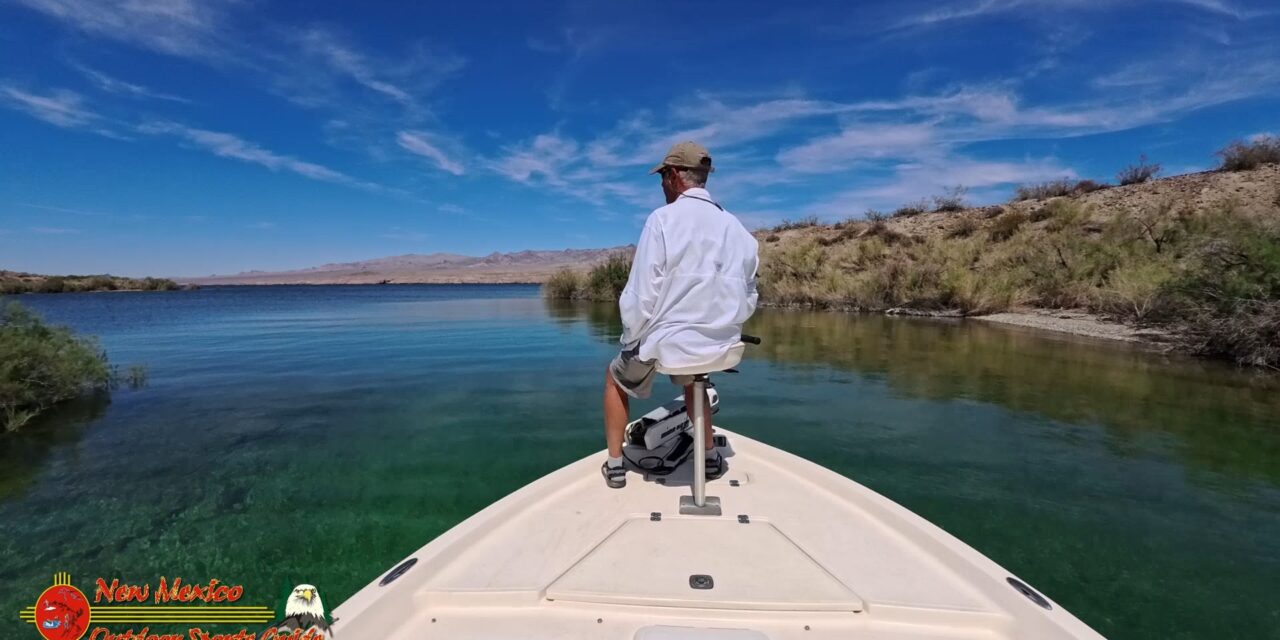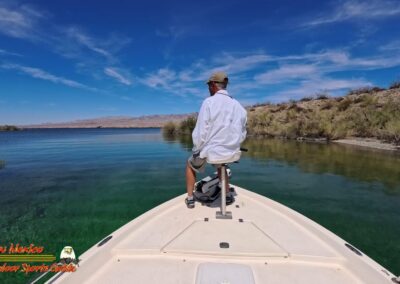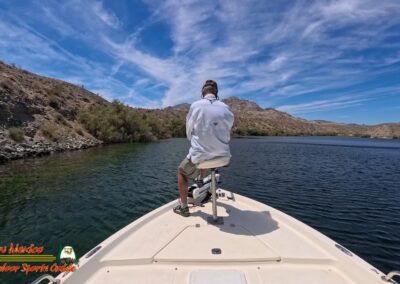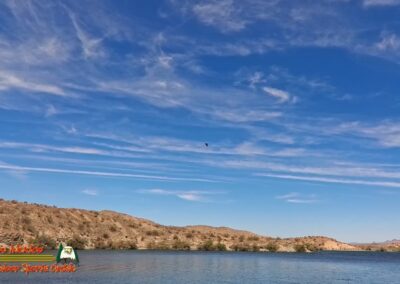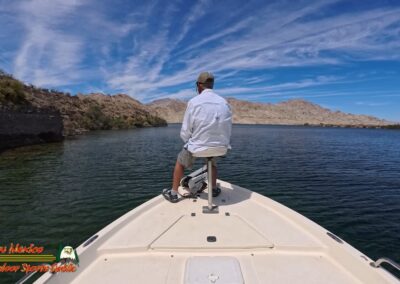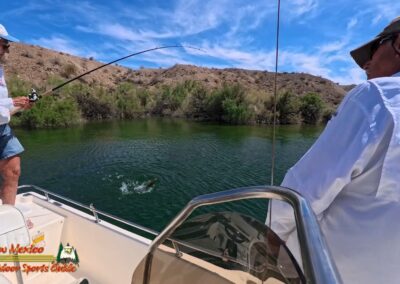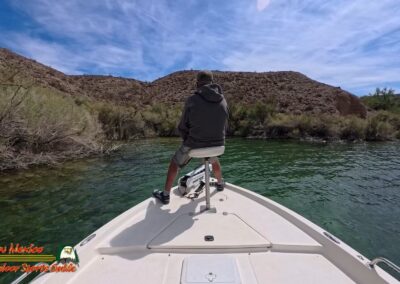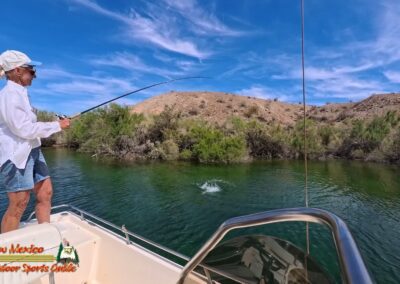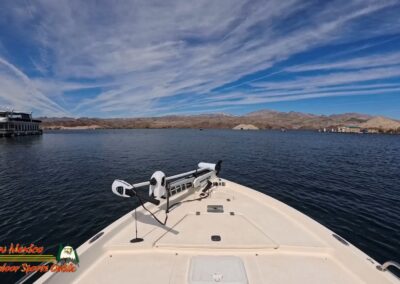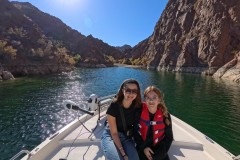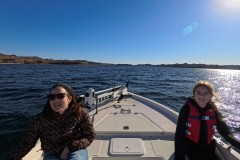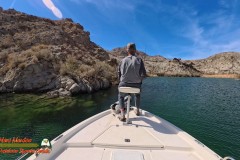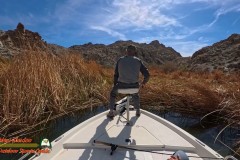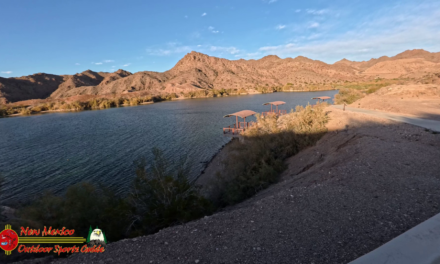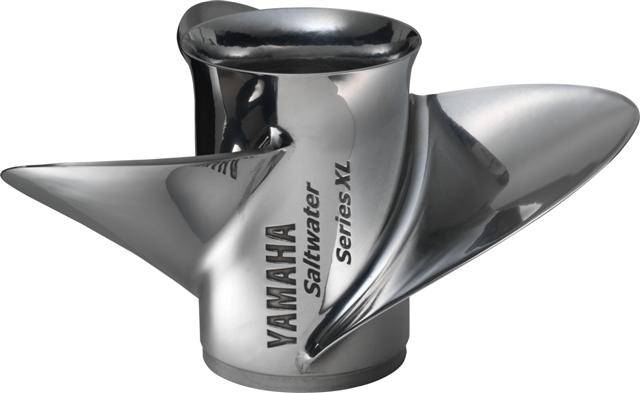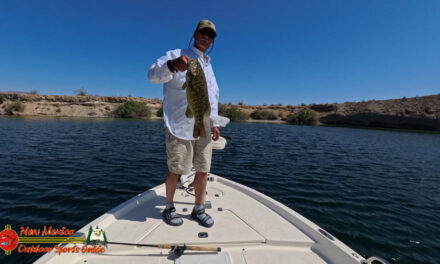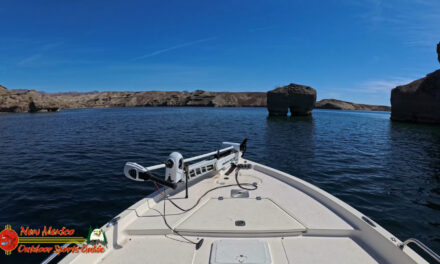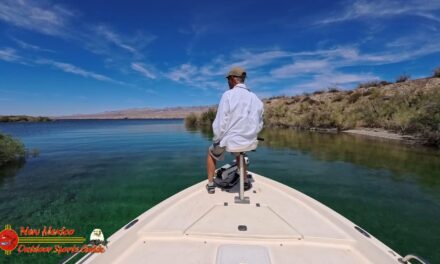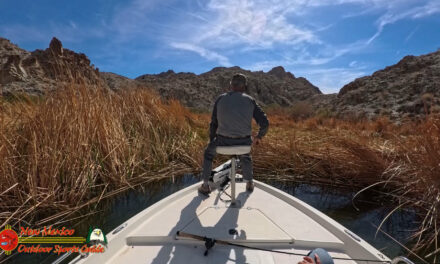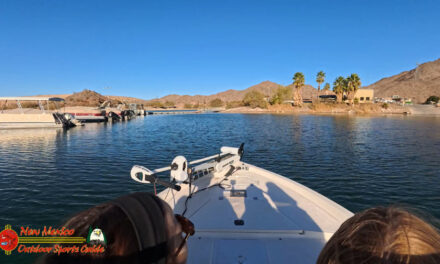The morning sun cast a golden glow across the placid waters of Lake Mohave as Paulette and I backed our trailer down the ramp at Katherine’s Landing Marina. After spending most of our winter days exploring the shorelines and coves of this magnificent body of water, we had one lingering question on our minds: were the smallmouth bass still spawning in late April?
At 10:00 AM sharp, with our 20-foot Key West center console boat loaded with supplies for the day, we pushed off from the dock and headed north up the lake. The morning air carried a hint of desert sage mixed with the unmistakable freshness of water – a combination that never fails to invigorate my old bones and remind me why we choose to winter in this corner of Arizona.
The Colorado River’s Hidden Jewel
Lake Mohave stretches nearly 67 miles along the border between Nevada and Arizona, created when Davis Dam corralled the mighty Colorado River. Unlike its massive sibling Lake Mead to the north, Mohave maintains a certain intimate quality that has always appealed to us. The sapphire waters, backdropped by the rugged desert mountains including the majestic Spirit Mountain to the west, create a landscape that continues to take my breath away even after all these years.
“Pat, look at how clear the water is today,” Paulette called out as we cruised at a comfortable speed, our wake spreading behind us like unfurled ribbons. The clarity was indeed exceptional – easily 20-30 feet of visibility in the main channel. This remarkable transparency is one of Lake Mohave’s defining characteristics and makes it perfect for our mission today: observing smallmouth bass on their spawning beds.
At 81, I’ve witnessed countless natural wonders across the American Southwest, from the rolling Flint Hills of my Kansas boyhood to the snow-capped majesty of Wheeler Peak visible from our summer home in Angel Fire. Yet the underwater drama of spawning bass never ceases to fascinate me.
Understanding the Smallmouth Spawn
As we navigated toward our favorite coves, I found myself reflecting on the smallmouth bass spawning behavior that has fascinated me since I first learned about it decades ago. These remarkable creatures, not native to these waters but thriving nonetheless, follow an ancient ritual when spring water temperatures climb into the upper 50s to mid-60s degree range.
The males arrive first to the spawning grounds, usually selecting areas with pea-sized gravel or small rocks in 3-15 feet of water. With determination that would impress any homebuilder, they create circular depressions in the substrate by fanning their tails – creating what anglers commonly call “beds.” These underwater nurseries are carefully constructed and fiercely defended by the males, who turn noticeably darker during the spawning period.
When females arrive, typically when water temperatures stabilize around 60-65 degrees, the courtship begins. The male will swim alongside her, occasionally nudging her side, essentially encouraging her to deposit her eggs in his meticulously prepared nest. Once she releases her eggs – potentially thousands of them – he follows immediately with his milt to fertilize them. Sometimes multiple females will visit a single male’s nest, adding to his paternal responsibilities.
What happens next always strikes me as remarkable – the female, her biological duty complete, swims away while the male remains to guard the eggs and eventually the tiny fry. For up to four weeks, he’ll hover over the nest, protecting his offspring from predators, fanning oxygen-rich water over the eggs, and even retrieving wayward fry that stray too far from the safety of the nest.
The Search Begins
“Let’s try that cove near Cottonwood Basin,” I suggested to Paulette as we throttled down to idle speed. This particular cove had been productive in previous years, with its gradual slope and perfect mix of gravel and small rocks creating ideal spawning habitat.
As we eased into the cove, I grabbed my polarized sunglasses – an absolute necessity for bed spotting. The glare of sunlight on water makes it nearly impossible to see beneath the surface without them. With the sun high overhead, conditions were perfect for our observations.
“Cut the engine,” I said to Paulette, who skillfully shifted to neutral while I lowered our small trolling motor. We cruised silently in about 8 feet of water, scanning the bottom for the distinctive circular depressions that would indicate spawning activity.
“Nothing here,” I murmured after several minutes of careful observation. “The water temperature might give us a clue.”
I dipped our digital thermometer into the lake and waited for the reading to stabilize. “Sixty-six degrees,” I announced. “Definitely in the spawning range, but probably toward the tail end of the activity.”
We pulled the trolling motor and moved deeper into the cove, this time cutting closer to a rocky point that jutted into the water. As we drifted along, Paulette suddenly pointed toward the bow.
“Pat! Look at that beauty!”
Following her gaze, I spotted a chunky smallmouth, likely over three pounds, cruising parallel to our boat about 10 feet away. Unlike the dark males guarding nests, this fish displayed the beautiful bronze coloration that gives smallmouth their distinctive look.
“That one’s not on a bed,” I observed, noting its casual swimming pattern. “Probably a female that’s already spawned out.”
Paulette’s eyes lit up with that familiar sparkle that appears whenever fishing opportunities present themselves. “We weren’t planning to fish today, but…”
I chuckled, knowing exactly what she was thinking. After 40-plus years of marriage, words are sometimes unnecessary between us. “Go ahead,” I said with a smile. “One cast won’t hurt.”
An Unexpected Trophy
Paulette reached for her favorite rod, already rigged with a 4-inch green pumpkin tube jig – a classic smallmouth bait that mimics crayfish. With the practiced ease of someone who’s made thousands of casts over the years, she flipped the lure just beyond where we’d last seen the fish.
The tube jig sank slowly through the crystal-clear water, its tentacles waving enticingly as it descended. Paulette maintained slack in her line, watching it intently for any unnatural movement that would indicate a strike.
When the line suddenly twitched to the left, she reacted with reflexes that would impress someone half her age, setting the hook with a sharp upward sweep of the rod. The water exploded as the smallmouth launched itself airborne, its bronze scales flashing in the sunlight.
“It’s a good one!” she exclaimed, maintaining pressure as the fish dove deep, then made another spectacular leap.
I positioned myself at the gunwale, watching with pride as my wife skillfully played the powerful fish. After three more jumps and several determined runs, the smallmouth began to tire. Paulette guided it toward the boat, and I lipped it.
“What a beauty!” I said as I gently removed the hook. The smallmouth was indeed impressive – a female with a distended belly indicating she had yet to spawn. We quickly weighed her on our digital scale: 3.6 pounds – a quality Lake Mohave smallmouth by any standard.
After a quick photo to document the catch, we revived the fish alongside the boat and watched her swim strongly back to the depths. Conservation has always been important to us, particularly during spawning season when these fish are fulfilling their biological imperative.
“One cast, one fish,” Paulette said with satisfaction. “I’ll quit while I’m ahead.”
Nature’s Intimate Dance
We continued exploring, moving from cove to cove along the lake’s eastern shoreline. Around midday, we entered a secluded bay just north of Cabinsite Point. As we idled toward the back of the cove, I spotted what looked like several circular depressions in about 5 feet of water.
“Beds at two o’clock,” I said quietly, pointing toward an area near a submerged boulder. Paulette cut the engine, and we drifted closer, careful not to cast shadows over the area that might spook the fish.
What we witnessed next was one of those rare, magical moments that etch themselves permanently in memory. Three smallmouth bass – one slightly smaller fish with distinctly darker coloration and two larger, more bronze-colored fish – were engaged in an intricate spawning ritual directly over one of the beds.
“The dark one’s the male,” I whispered, though there was no need for silence. “And those two larger ones must be females.”
We watched, transfixed, as the three fish swirled around each other in tight circles above the carefully prepared nest. The male would occasionally dart at one of the females, bumping against her side in what appeared to be encouragement to release her eggs. The females would respond by tilting slightly sideways, possibly releasing eggs, though it was impossible to see the microscopic eggs themselves.
“In all our years watching for spawning activity, we’ve never actually caught them in the act,” Paulette said softly, her voice filled with wonder.
For what must have been fifteen minutes, we remained perfectly still, privileged observers to one of nature’s most intimate dances. The fish seemed oblivious to our presence, so focused were they on their ancient biological imperative. The male would occasionally dart away to chase off a smaller fish that ventured too close to the nest, before quickly returning to the spawning females.
“This is why we come out here,” I said, feeling that familiar swell of gratitude that often overtakes me when witnessing such moments. At my age, I’ve come to treasure these experiences even more deeply, recognizing them as the precious gifts they are.
Midday Break
By noon, the sun was high overhead, and the temperature had climbed into the mid-80s. We decided to take a break and enjoy the lunch Paulette had prepared before leaving our winter home in the foothills overlooking the lake.
We anchored in a sheltered cove with just enough shade from an overhanging cliff to provide relief from the direct sunlight. Paulette produced her specialty – beans with smoked sausage, kept chilled in a cooler – along with some fresh fruit cocktail.
As we ate, we discussed what we’d observed throughout the morning.
“The spawn is definitely winding down,” I noted, taking a sip of cold water from my insulated bottle. “From what I’ve read and observed over the years, when water temperatures hit the mid-60s like today, we’re seeing the tail end of it.”
Paulette nodded in agreement. “Remember two years ago when we came out in early April? The lake was absolutely littered with beds in every cove.”
That had indeed been a spectacular year, with water temperatures warming earlier than usual, triggering a concentrated spawn that had smallmouth beds visible in nearly every suitable location. Today’s observations suggested that most of the spawning activity for this season had already occurred, with just a few late participants still engaged in the ritual.
After finishing our lunch and enjoying a short rest, we stowed our trash (leaving no trace has been our mantra long before it became a popular environmental slogan) and prepared to continue our exploration.
Afternoon Observations
Refreshed from our break, we spent the next couple of hours methodically checking additional coves and potential spawning areas. We spotted several more beds, most of them empty or with a single male still guarding fry too small for us to see from the surface.
In one particularly rocky area, we observed a male smallmouth aggressively chasing away a school of bluegill that had ventured too close to his nest. His determination was impressive, darting back and forth with surprising speed for a fish that appeared to be at least four pounds.
“He hasn’t left that spot for days, I’d wager,” I commented, admiringly. “No eating, minimal rest, just constant vigilance.”
The parental dedication of male smallmouth has always struck me as remarkable. Unlike many fish species, or even some humans I’ve known over my eight decades, the male smallmouth demonstrates extraordinary commitment to his offspring. For up to four weeks, he’ll remain on guard, fanning water over the eggs to keep them oxygenated and free from silt, protecting them from the many predators that would make a quick meal of eggs or fry.
By 3:00 PM, with the afternoon breeze beginning to create small whitecaps on the main lake, we decided it was time to head back to Katherine’s Landing. Our mission had been accomplished – we’d confirmed that while some spawning activity was still occurring, the majority of Lake Mohave’s smallmouth bass had completed their reproductive duties for the year.
Heading Home
As we navigated back down the lake, Spirit Mountain loomed majestically to the west. The rugged peak, sacred to several Native American tribes, served as a silent witness to the cycles of life that had played out in these waters long before Davis Dam created Lake Mohave and would continue long after our brief time here was done.
The afternoon light cast a different quality over the landscape than the morning sun had, highlighting the rusty reds and deep purples of the desert mountains against the azure sky. I pulled out my camera – a constant companion on these outings – and captured a few shots of the dramatic scenery.
Photography and videography have become increasingly important to me in my later years, serving as both creative outlets and methods of preserving memories. From the tallgrass prairies of my Kansas childhood to the alpine meadows near our Angel Fire summer home, I’ve attempted to capture the essence of the landscapes that have shaped my life. Lake Mohave, with its dramatic contrasts between water and desert, provides endless opportunities for compelling images.
By 4:30 PM, we had the boat safely loaded on our trailer and were heading back to our winter place in the foothills. The day’s adventure – witnessing the miracle of spawning bass, Paulette’s perfect one-cast success, and hours spent on the water we’ve come to love – had been deeply satisfying.
Reflections Over Iced Tea
Back at our home, with the boat rinsed and secure, Paulette and I settled onto our patio overlooking the lake in the distance. Tall glasses of iced tea sweated in the late afternoon warmth as we replayed the day’s highlights.
“That spawning display was something special,” Paulette said, her eyes gazing toward the shimmering lake in the distance. “In all our years watching for beds, we’ve seen plenty of males guarding nests, but never the actual spawning moment.”
I nodded in agreement. “It’s a reminder of how much there still is to discover, even at our age.”
As the sun began its descent toward the western horizon, painting the sky in brilliant oranges and pinks, I felt that familiar sense of contentment that has become more frequent in my later years. From my boyhood days on our Kansas ranch, riding fences and dreaming of adventures beyond the horizon, to retired life split between our mountain home in Angel Fire and winters here along Lake Mohave, it’s been a journey filled with natural wonders.
The smallmouth bass we observed today, engaged in their ancient spawning ritual, are part of a continuous cycle of renewal that puts our human lives in perspective. As an octogenarian who has witnessed more seasons than many, I find comfort in these consistent natural rhythms.
Tomorrow, we might return to the lake with fishing as our primary purpose rather than observation. Or perhaps we’ll explore one of the many desert trails that wind through the surrounding mountains. Whatever we choose, we’ll approach it with the same sense of wonder and appreciation that has characterized our decades together in the magnificent American Southwest.
For now, though, we’re content to sip our tea, watch the sunset paint the landscape in ever-changing colors, and appreciate the day’s gift – a glimpse into the underwater world of spawning smallmouth bass in the crystal clear waters of Lake Mohave.
About the Author: Pat and his wife Paulette divide their time between their mountain log home in Angel Fire, New Mexico, and their winter residence overlooking Lake Mohave, Arizona. An avid outdoor photographer and videographer, Pat documents the natural beauty of the American Southwest through his lens. His work showcases his deep passion for the mountains, alpine valleys, wildlife, forests, rivers, streams, lakes, and deserts of the region that has captured his heart after eight decades of adventures.

